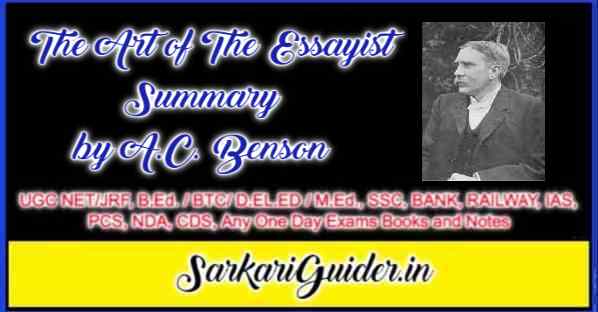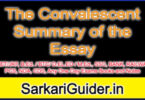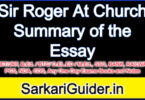
The Art of The Essayist Summary by A.C. Benson
The Art of The Essayist Summary – An essay is something which someone does himself. The subject is not important but the personality of the essayist who conceives and records his impressions, who vividly apprehends, enjoys and expressed his thought with a certain gusto on anything whatsoever – from serious to trivial. All literature represents life in certain form of human expression; the essay being the expression of the reveries under whose spell a man says, “Says I to myself, says I”.
Though Montaigne is credited with being the originator of the essay form, the roots of it lie far back in history. He owed a great deal to Cicer who treated abstract topics in a conversational way with a romantic background, and who in turn was indebted to Plato whose dialogues contained the germ of both novel and the essay. Plato’s dialogues were, however, more dramatic whereas soliloquy seems to be the essence of the essay. Cicero was a bit of both a preacher and an essayist twaddled with familiar ethical problems of conduct and character,catering to the needs of thoughtful readers. The charm of Montaigne’s essays consists in the charm of his personality – frankness, gusto, acute as he observation, lively acquaintance with men and manners. Montaigne is not ashamed of recording what interested him and is endowed with a discreet shamelessness’ which should be the asset of a good essayist.
The essay form kept on changing with changing times and essayists trying their hands at it. Thomas Browne had an elaborate rhetorical style with its long winding ethereal sentences. Addison treated with delicate humour life and its problems and created almost a new form of essay by incorporating emotional sentiments aroused by solemn scenes and fine associations, Charles Lamb romanticised the most ordinary experiences of life imbuing them with emotion and humour. De Quincey wrote a sort of impassioned autobiography while Pater used essay as the medium for the expression of exquisite artistic sensation. These are some of the forms English essay has taken. But the common underlying essence of essay has always been the same; it is personal sensation, personal impression, evoked by something strange or beautiful or curious or interesting or amusing.
This personal element would have made partake something of the flavour of lyric had it not been for the predominant role of humour in it which is out of place in a lyrical or for that matter, poetic composition i general. This, however does not mean that an essayist is forbidden from lapsing into a poetic mood. In developed literature the distinction between poetry and prose gradually gets blurred and prose like poetry can be used as a vehicle for kindling emotion. This flexibility of medium is nowhere so apparent as in the essay. The material of essay is drawn from the common scenes, experience and emotions of life and in this sense the essayist is a ‘Spectator of life’, who, however, does not bother about moral implication of events and characters that go to constitute the vast pageant of life,The essayist establishes a sort of friendly relationship with his readersand gives expression to the half-formed, ill-digested ideas, vague emotions, impressions originating from scenes, events, art and books, albeir not in a systematic, hard bound manner, but in a suggestive and persuasive way, The vast mass hum ity with its follies and faibles does not displease him, rather it enriches his experience and cater to his unusually curious disposition. He is not ashamed of human weakness or shocked by them, but at the same time aware of the majesty of humanity, making one realize that humanity is at once above itself and in itself, and that we are greater than we know. The true essayist makes us feel that life is a fine sort of game and we all have a part in it, thus making us interested in life and ourselves.
The essayist reveals to us the secret that the worth of experience is not measured in terms of success, but rather rests on a fulness of life : Success rather tends to obscure and diminish experience. In this the essayist is more like a poet, with this difference of course, that he works with simpler and humbler materials and can be said to bask not in the ‘glory’ but in the glow of life.
So many different strands of motifs make essay a very flexible yet hard to define literary genre. But a workable definition can be arrived, say, by defining it as a little criticism of life at some one point clearly enough defined.
The essayist belongs to each and every category of human explorer and expresser in the field of arts and letters without fitting into any one of them.
His method is analytic in the sense that whatever he observes, he lets his fancy play over their beauty and significance, his sole purpose being to enable his fellow human beings to love life a little better, and prepare them for lifes’ infinite, variety, its joys and mournful surprises.
- The Rattrap Summary written by Selma Lagerlof in Hindi and English
- Deep Water Summary written by William Douglas in Hindi and English
- Lost Spring (Stories of Stolen Childhood) Summary written by Annes Jung Hindi and English
- The Last Lesson Summary written by Alphonse Daudet in Hindi and English
- Twelve Million Black Voices Summary by Richard Wright
- On Doing Nothing by J.B. Priestley Summary
- Pleasures by Aldous Huxley Summary In Hindi
Important Links
- John Keats Biography
- Percy Bysshe Shelley Biography
- William Wordsworth as a Romantic Poet
- William Wordsworth as a poet of Nature
- William Wordsworth Biography
- William Collins Biography
- John Dryden Biography
- Alexander Pope Biography
- Metaphysical Poetry: Definition, Characteristics and John Donne as a Metaphysical Poet
- John Donne as a Metaphysical Poet
- Shakespeare’s Sonnet 116: (explained in hindi)
- What is poetry? What are its main characteristics?
- Debate- Meaning, Advantage & Limitations of Debate
- Sarojini Naidu (1879-1949) Biography, Quotes, & Poem Indian Weavers
- Charles Mackay: Poems Sympathy, summary & Quotes – Biography
- William Shakespeare – Quotes, Plays & Wife – Biography
- Ralph Waldo Emerson – Poems, Quotes & Books- Biography
- What is a lyric and what are its main forms?






